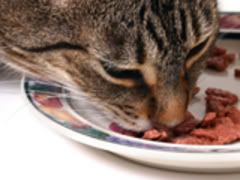
At any age, most cats enjoy a variety of canned, semi-moist and/or dry food along with an occasional treat of meat/fish. Nutritionally well balanced cat food provides a diet for your cat while occasional complementary food should be fed as a treat only. At about seven or eight years of age, most feline digestive systems become less efficient and therefore require several smaller and easier-to-digest meals.
If your cat eats mostly canned food, make sure that you always clear away or refrigerate uneaten food, otherwise it will become stale and may cause digestive upsets with older cats if eaten later. There is also a variety of life-stage foods available which are aimed specifically at older or less active felines. These suit an older cat’s digestive system and help to reduce the risk of obesity in less active cats. And unless your cat has problems digesting ordinary cat food, is becoming overweight or is on prescription food, ordinary complete formulation cat food accompanied by fresh drinking water is adequate.
At some point in an older cat’s life they may begin to loose their teeth. Most cats manage very well without teeth, but if your cat has problems you can chop tinned food to a manageable consistency. Some of the very firm foods can be mashed with gravy, tomato juice from a sardine can or warm water to give them the consistency your cat prefers. Gravy can also be added to dry food to soften it. If your cat is experiencing difficulty in eating or has lost its appetite, it should be examined by a vet in case there is an underlying problem. Likewise, a suddenly increased appetite, especially if it is coupled with weight loss or poor condition, needs to be investigated. Signs of poor diet include thin, dull coat, excessive shedding or dandruff, weight loss, vomiting, diarrhea, yellow teeth and mouth odor.







